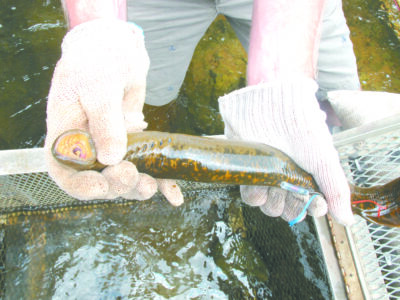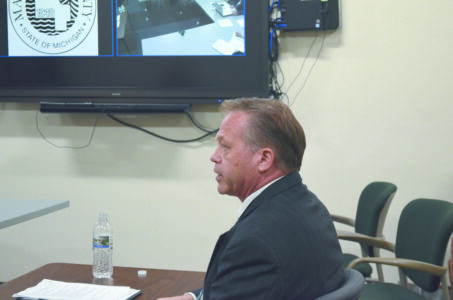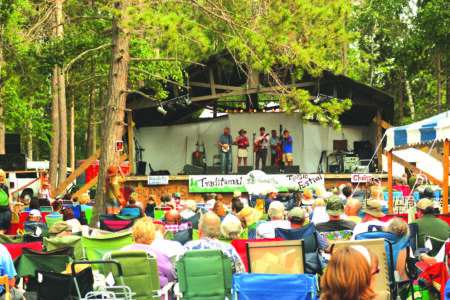‘Resiliency’ and ‘relevancy’
Michigan Department of Natural Resources celebrates centennial

Michigan conservation officer Jennifer Hanson checks deer hunting licenses and chats with hunters Craig Vining of downstate Alpena, left, and Randy Earnest of downstate Big Rapids on a November day in Iron County. (Photo courtesy of the Michigan Department of Natural Resources)
MARQUETTE — The words “resiliency” and “relevancy” are two new main drivers behind the mission of the Michigan Department of Natural Resources, which is celebrating its centennial this year.
DNR Director Dan Eichinger talked about the notable milestone in an interview with The Mining Journal.
Eichinger said the centennial is the story of the first 100 years of conservation in Michigan as well as the U.S., noting the parallel of the birth of the state and federal conservation movements.
Landscapes needed to be restored, and iconic game and fish species needed to recover — two concepts that drove the DNR’s first century.
Restoration and recovery marked the two “R words” that might have defined the agency’s first 100 years, he said.
“I think there’s two new ‘R words’ that I would add into that lexicon,” Eichinger said. “Obviously, we’re going to continue to do that core fish and wildlife and landscape that we do, but we need to start making a turn now to think a little bit more about resiliency and relevancy.
“And so when we talk about resiliency, we know that the universe of sort of existential threats that exist has changed a lot, even in a relatively short period of time — fish and wildlife, health issues, invasive species, the negative effects of climate change and how that expresses itself on the landscape.”
All this, he noted, means the DNR needs to put itself on a “management footing” with an eye toward resiliency.
“How do we steward species? How do we steward landscapes through this period of change and to make sure that things like our cold-water rivers are still cold 20, 30, 40, 50 years from now, even as climate change has an impact?” Eichinger asked. “How do we make sure that we have the same mix of diversity of wildlife species that we enjoy today, even against this backdrop of change?”
He acknowledged that will be a challenge.
And regarding relevancy, the DNR might have another challenge.
“We need to make sure that the work that we do, the programs that we offer and the ways that people connect with our department and connect with nature in general, that that’s accessible and that’s available and welcoming to all the people who call the state of Michigan home,” Eichinger said.
He believes it’s incumbent on the DNR to ask people what they need of the agency, which has many stakeholders with whom it works on a variety of issues.
Eichinger mentioned reaching out to people as such a focus for the next 100 years.
“There’s a lot of folks that live in our state that we don’t hear from very often, or we don’t see in our parks or that we don’t see in the game areas or at the boat launches or whatever, and so I think it’s really important for us to kind of reach out beyond sort of our known borders and find those folks, and talk to the folks and ask them what they need from us,” Eichinger said.
The first 100 years
According to the DNR, its precursor — the Michigan Department of Conservation — was created on March 30, 1921, through legislative executive action.
An important event that influenced the DNR took place on Sept. 2, 1937, when the Federal Aid in Wildlife Restoration Act, now better known as the Pittman-Robertson Act, was passed by lawmakers in the U.S. Congress. The act apportioned 10% of a federal excise tax on sporting firearms and ammunition to states for a wide range of land acquisitions and projects.
The legislation today provides a vital funding source for the DNR, it said. Distributed through a formula, the money pays for up to 75% of cost-approved projects including improvement of wildlife habitat, introduction of wildlife to suitable habitat, research, surveys and inventories of wildlife problems, hunter education programs, and acquisition and development of public access facilities such as public shooting ranges.
Michigan received a total of $17.9 million in Pittman-Robertson dollars in fiscal year 2020.
Patterned after the Pittman-Robertson Act, the Federal Aid in Sport Fish Restoration Act passed Congress on Aug. 9, 1950, and now is commonly known as the Dingell-Johnson Act. Although the act has been amended several times, the fund’s proceeds still are supported by excise taxes on fishing tackle and are apportioned to states, but the fund also gets revenue from a portion of federal gasoline taxes, interest on the fund, and import duties on fishing tackle and various watercraft.
The fund typically provides 75% of project costs, with states providing the remaining 25% in matching money derived from the sale of fishing licenses.
Amendments to the law have provided funding for wetlands restoration, aquatic education, boat safety and clean vessel sanitation devices, and a non-trailer-able boat program.
A total of $11.5 million in Dingell-Johnson funding was apportioned to Michigan in 2020.
The Michigan Department of Conservation’s name was changed to the DNR in 1968 to reflect increasing responsibilities.
On Aug. 3, 1972, the Michigan Legislature passed the Wilderness and Natural Areas Act. In 1973, DNR recommendations for inclusion under the act, presented to the Natural Areas Advisory Board and encompassing about 42,000 acres, resulted in renaming Michigan’s largest state park as Porcupine Mountains Wilderness State Park.
In 1995, Public Act 59 worked to repeal the act since its provisions were now contained within broader legislation governing many areas of environmental protection. These provisions currently are part of the Natural Resources and Environmental Protection Act of 1994, which took effect on March 30, 1995.
Also in 1995, then Gov. John Engler created the Michigan Department of Environmental Quality, which transferred environmental regulatory functions from the DNR to the new department. However, in 2009, then Gov. Jennifer Granholm merged the DNR and DEQ into the Michigan Department of Natural Resources and Environment. Then in 2011, Rick Snyder, who was governor of Michigan at that time, split the DNRE back to the DNR and DEQ.
Gov. Gretchen Whitmer in 2019 reorganized the DEQ, renaming it the Department of Environment, Great Lakes and Energy.
Because of the COVID-19 pandemic, the DNR has had to scale back its originally envisioned centennial celebration. However, people can note the event by learning about what the DNR has called “100 ways to celebrate the centennial” at https://bit.ly/3dfRKrt.
Expanded challenges
Eichinger said the DNR’s core functions remain the same — adapting to invasive species, fish and wildlife, and climate health.
The issues, though, are wider in range.
“We used to think about invasive species as being just zebra mussels and quagga mussels and sea lamprey, and that universe has expanded as well,” Eichinger said. “We start to see these things that we might have predicted not that long ago as being like, ‘That’s something we’re really going to have to think about in the future.’ Well, the future is here now and we really have to wrestle with some of those challenges, and that’s kind of what we’re grinding against, and what we’re trying to shift and pivot towards is making sure that we’re being responsive to those contemporary resource management challenges.”
Being a government body can mean having to navigate bureaucratic mazes.
However, Eichinger stressed that DNR employees are immersed in natural resources apart from their workplaces.
“Maybe unlike other types of government work, the women and men who work in the Department of Natural Resources — this is not a job,” Eichinger said. “Many of us feel the call to do this work, and we are all in our own way and in different ways active users of the natural resources, however it is we choose to do that — hunt, fish, hike, bike, camp, boat, whatever it might be.”
Some elements of their work are bureaucratic in nature, which he noted come in the form of rules and regulations that govern access to these resources.
However, Eichinger called the DNR “a hub of innovation.”
“It’s really exciting to work alongside folks in our department because they bring that attitude to work with them every single day,” he said.
Michigan’s varied landscapes also can pose different issues when it comes to conservation.
“Everybody can tell as soon as you cross the (Mackinac) bridge into the Upper Peninsula, it’s just a profoundly different ecosystem than what you find in Lower Michigan, and so the management challenges are different and more complex,” Eichinger said.
For example, he pointed out that the DNR has to manage fish in warm waters as well as cold waters.
Then there are varying issues statewide with wildlife, state forests, minerals and fisheries.
“It just makes for a very complex environment, but that’s one of the reasons, I think, that our agency is viewed as a leader among its peers in the country, because we have really complex management responsibilities,” Eichinger said.
Special patch to be created
The DNR is asking artists to submit designs for the special DNR centennial edition 2021 deer management cooperator patch.
The Michigan deer management cooperator patch, given to those who bring their harvested deer to a DNR check station, has been a popular collector’s item for hunters since the early 1970s.
This year’s patch will commemorate the DNR’s centennial, which the department is celebrating throughout this year. Learn more at Michigan.gov/DNRCentennial.
Design submissions for the 2021 deer management cooperator patch are due April 23.
Anyone can enter the contest. Entries must be designed using the centennial template and must portray white-tailed deer or white-tailed deer hunting in a Michigan habitat. The work must be original and submitted by the artist.
Complete contest information and submission guidelines are available at Michigan.gov/Deer under Cooperator patches. This year’s contest winner will be contacted in early June.






